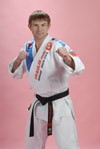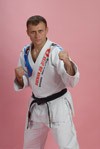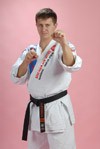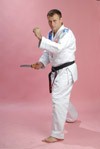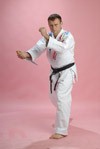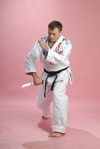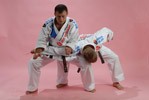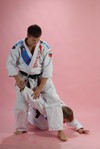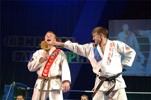Tanto-jutsu
History
Tanto-jutsu is a collective term for styles, schools and methods of conduct
of knife fighting. This term was seldom used by medieval Jiu-jitsu schools
which were established very early in the Tokugava period and they mainly
included holds which originated on a field of battle. Daggers and short
swords were used for Yoroi Kumiuti - that means literally "wrestling in
armour" (the first hieroglyph means "armour, cuirass", the second hieroglyph
means "company, union, set"). Martial arts which studied carefully Yoroi
Kumiuti called Kogusoku Kosi No Mavari (or sometimes in abbreviated form
just Kogusoku) and more seldom Yoroido Sino Jutsu in case if they got
training with Yoroido Si and ignored another types of daggers.
Takenouti-ryu is reputed as one of the oldest Jiu-jitsu school that
maintained Kogusoku tradition.
If a warrior is dressed in amour the number of zones on his body to defeat is sharply decreased. So when warriors practiced holds of wrestling, while in amour, they are trained to pierce the parts of armour that were weaker and more open to injury. Also they were to seek an opponent's throat, armpits, flexions of elbows, inside part of legs, back part of knee flexion and ankle-bone. They handled daggers both with straight and return way.


Knives Tanto completely satisfied these criteria.
Tanto
TANTO (the first hieroglyph - "short") is a general collective term for different kinds of daggers which length is no more than one Syaku.
Tanto are large types of fighting knives with blades 25 - 40c long (on average 30c) and they have a proportionate tsubu and usually a wicker handle with all appropriate details such as kasira, menuki, fuchi. There are grooves in the sheath to put kogai and kogatani into them. This reliable weapon provides a good chance for fighting with a heavily armored opponent. They were made both with a ridged winding line of forging Sinogitsukuri (the first hieroglyph - "hardening", the first one - "surfacing, texture") and without it - KHIRADZUKURI (the first hieroglyph - "soft, gentle, peaceful"). TANTO were both with TSUBA (in general "garda", but literally "polya") for example, KHAMIDASI, and without it, for example, KAIKEN.
TANTO was divided into many different models according to the time period for which is was made, purpose of application requirements and fastening an edge to its handle:
- YOROIDO SI (the second hieroglyph - "pass through, release")
- METEDZASI (the first hieroglyph - "right", the second one - "hand", the third one - "finger")
- HAMIDASHI (the first hieroglyph - "eat", the second one - "go out, send out")
- AIKUTI (the first hieroglyph - "meeting, meet", the second one - "mouth")
- KAIKEN (the first hieroglyph - "chest, bosom")
- HIMOGATANA (the first hieroglyph - "lace")
- KOSHIGATANA (the first hieroglyph - "loin, hip")
- SHITO (the first hieroglyph - "pierce, prickle")
Of course there were significant difference between TANTO constructed for
puncture of armour and TANTO designed for self-defense from opponents in
usual civilian clothes. YOROIDO SI had an ultra strong edge that was almost
straight because this weapon was principally designed for assault thrust
wounds.
HAMIDASHI is a fighting knife very similar to tanto except tsuba which it
doesn't have at all. Its blade is detached from sheath and its handle and
has a small elevated band, which forms with edging of mouth of sheath as if
two halves are a single whole.
HAMIDASHI were both wide and narrow.

AIKUTI are the most common kind of knives that have both different sizes (blade 10 - 30c long) and all sort of handles and sheaths. The distinction is that there is no mark on the border with the blade. The most one can find here is a thin rim made of metal or of the handle itself.
If a wicker is one of the classification characteristics for tanto and khamidasi, then a handle of aikuti was seldom classified this way. They traditionally have a plain or a luxurious carved handle (wood, bone, lacquer). Covering the rounded part with leather (same-kava) is a common style. Also, small menuki were installed on each side and the butt-end was fastened with a tsuka-gasira head.
AIKUTI blades are wider at the basis of the handle. KAIKEN had never sported a lot of decoration. Its handle and sheath were "zapodlitso" and always very smooth and often lacquered.
In some cases, the material and design of sheath appear to be just an extension to the handle, so that a knife looks as part of one style unit. The joint is sometimes invisible all together or so badly marked that you are unsure about what side to retrieve. This is especially true for those made of polished wood and bone with no metal details but a blade.
Warriors carried all types of knives in their belts as swords. Large knives like vakizasi were carried at the side and medium ones were carried almost on the stomach. Small aikuti were their secret weapon, so they could be put wherever they could be hidden, in sleeves, in bosom and etc.

Warriors' wives and daughters also learned how to use daggers which they carried along for self-defense. They may also use them to commit suicide, by slicing the jugular vein on their neck, thus providing them with no disgrace in death. Women usually carried Kaiken or a small AIkuti along. Kaiken was usually put into Futokoro, a special kimono tuck carried on their chest. They sometimes put a smaller dagger into Tamoto (the wide part of the kimono sleeve). The complex holds are specifically perfected in imitation of Kaiken and was just called Kaiken-jitsu.
In the middle and at the end of the period Tokugava, inexpensive knives with frailer blades such as Kaiken and small Aikuti were experienced increased production. Since the tradition of continual wear armour outwardly and secretly had become the thing of the past, using knife techniques and requirements of construction of its handle and its blade changed. At the same time new schools were established, for example Tendzin sin ryu, which mainly perfected passive complexes of defense techniques. In many schools tactics of using Tanto were focused in many respects upon "counter-attack against counter-attack" and great efforts were made to develop skills in inflicting serious injuries to an opponent that tried to disarm you and snatch (dislodge) your knife out of your hand.
As the experienced fighters continued to develop their skills in disarmament, an armed man with a knife would have several disarmament techniques. Warriors who preferred a knife, for any reason, began to cover themselves and their opponents with additional steps. As the necessity to get training in armed pairs fighting arises, more and more Jiu-jitsu schools have begun to use safety models of Tanto such as BOKUTANTO (the first hieroglyph - "wood") and SE FUKUROSINAI (the second hieroglyph - "bag", the third hieroglyph - "bamboo").
The word "Futokorogatana" that is written in the same hieroglyphs as the word "Kaiken" means "secret ally, last hope, last support" in current Japanese. At the least two well-known and current martial arts schools, have special training complexes to train women in mastering Tanto. They are TENDO RYU and JIKISINKAGE RYU. Moreover JIKISINKAGE RYU has a special woman's KATA with a knife.
 If one reviewed different historical periods of development of different
old TANTO-JUTSU schools such as TAKENOUTI RYU, SEKIGUTI RYU, KHO KU RYU,
YAGYU SINGAN RYU then it is obvious that they focused more on attack and
less on defense with a knife. The last smallest sort of the knives was so
called "kogatana", a tiny secondary knife, was hid in a special sheath
pocket always inside that is closer to a body (URA).
If one reviewed different historical periods of development of different
old TANTO-JUTSU schools such as TAKENOUTI RYU, SEKIGUTI RYU, KHO KU RYU,
YAGYU SINGAN RYU then it is obvious that they focused more on attack and
less on defense with a knife. The last smallest sort of the knives was so
called "kogatana", a tiny secondary knife, was hid in a special sheath
pocket always inside that is closer to a body (URA).
It was used for quite peaceful purpose and appeared to be just a household
possession under conditions of autonomous field life. It was used to cut
sausage, if speaking the modern language. The little "helper" had a peculiarity.
Its blade was removable and inserted closely into its flat metal handle. As
it was used and sharpened frequently so a thin steel blade wore out
and became useless giving way to a new blade.
Training
Our suggestion is that you conduct Tanto-jitsu Basic Training; divided into levels of training. This allows you to become familiar with the basic, yet necessary, techniques and later you could continue to learn on your own. Those who are more trained will be able to take part in our competitions.
Workshops are conducted by the following coaches of our Association Komarov Maksim (4 Dan),
Berest Pavel (3 Dan), Kurilo Alexander (4 Dan).
Tanto-jitsu (first level)
Theory:
- safety measures working with a knife.
Practice:
- catches a knife - 1 hour
- standard attacks - 1 hour
- basic combinations - 2 hours
- studying and improving first kata - 2 hours
- studying and improving second kata - 2 hours
Tanto-jitsu (second level)
Theory:
- explaining rules and criteria for refereeing on tanto-jitsu - 1 hour
Practice:
- standard variants of attacks and defense (work in pairs) - 1,5 hours
- studying and improving kata №3 - 2,5 hours
- tanto-dori (self-defense) - 2 hours
- method of preparation for competitions - 1 hour
Tanto-jitsu (third level)
Theory:
- psychological aspects of a knife fighting - 1 hour
Practice:
- technique of combinations (intensive work in pairs) - 2 hours
- tanto-dori (self-defense - advanced techniques) - 2 hours
- studying and improving kata №4 - 3 hours
TANTO-JITSU competitions are conducted in three stages:
- KATA (formal complex)
- TANTO-DORI (self-defense from a knife)
- knife fighting (protective equipment)
Short clips on tanto-jitsu
|







 If one reviewed different historical periods of development of different
old TANTO-JUTSU schools such as TAKENOUTI RYU, SEKIGUTI RYU, KHO KU RYU,
YAGYU SINGAN RYU then it is obvious that they focused more on attack and
less on defense with a knife. The last smallest sort of the knives was so
called "kogatana", a tiny secondary knife, was hid in a special sheath
pocket always inside that is closer to a body (URA).
If one reviewed different historical periods of development of different
old TANTO-JUTSU schools such as TAKENOUTI RYU, SEKIGUTI RYU, KHO KU RYU,
YAGYU SINGAN RYU then it is obvious that they focused more on attack and
less on defense with a knife. The last smallest sort of the knives was so
called "kogatana", a tiny secondary knife, was hid in a special sheath
pocket always inside that is closer to a body (URA).